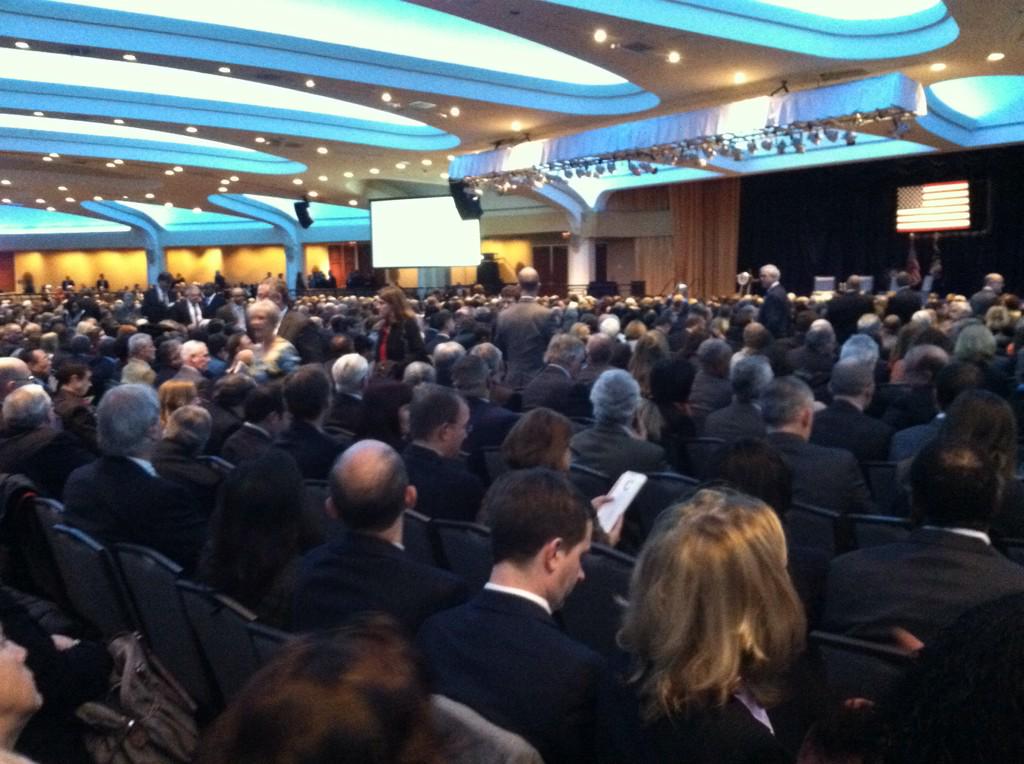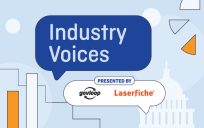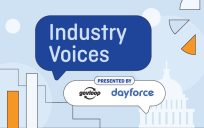This guest post was written by Dan Chenok, executive director of the IBM Center for The Business of Government.
This week, John Kamensky and I were privileged to attend the meeting of Senior Executives at the Washington Hilton, at which President Obama spoke as well as several agency heads. The event helped to frame why executive leadership remains a critical core of Federal workforce productivity and effectiveness on behalf of the American people, and the President introduced several initiatives intended to strengthen the executive core as well as the services that they lead for the Nation.
This event, the first of its kind under the current Administration, brought together several thousand Federal leaders (primarily SES, but also other senior executive designations – this post will refer to the group as SES henceforth), joined by a cadre of supporters of good government. The grand ballroom at the Hilton was full, and the mood was positive as the attendees listened to remarks from a variety of perspectives. General reactions to the event from attendees that we spoke with were very positive – we hope that meetings like this continue periodically, whether with the SES as a whole or through subsets of leaders across government.
A summary of the event, and areas where the IBM Center has done related work, follows.
Introduction and Panel Discussion – Agency Head Views
OPM Director Katherine Archuleta presented a short video highlighting Presidential Rank Award winners. Director Archuleta described Federal leaders’ impact in various fields that effect millions of Americans each day, including health care, disaster response, delivering loans to promote economic activity, and supporting small business. The Director reflected on the President’s priority about the importance of public service.
After another short video featuring stories of some notable recipients of the Partnership for Public Service’s Service to America Medals (SAMMIEs), a panel of agency heads took the stage, moderated by Rosemary Hart, a 2014 Presidential Rank Award Winner and SES leader from the Justice Department:
• Penny Pritzker, Secretary of Commerce
• Thomas Perez, Secretary of Labor
• Charles Bolden, Administrator of NASA
The three leaders spoke eloquently, and in a conversational and at times self-effacing manner, about their thoughts on leadership as well as the importance and impact of Federal Service. Interestingly, all three agencies were highlighted the following morning at the Partnership for Public Service’s annual event regarding the best agencies to work in government, and the panel demonstrated how the agency’s senior leadership is clearly an element of that success. Some key points from the discussion, which was framed around questions posed by SESers before and during the event, included:
Q: How do leaders such as yourself develop? Describe one personal leadership challenge you faced and how you overcame it?
Sec. Pritzker talked about leadership as creating an environment that empowers people – who she called the most important assets of any public or private sector organization – to act, to feel safe in taking risks and sharing information so they can focus on solving problems. A key value she discussed was encouraging people to identify problems early, when they are easier to fix, stating that “crises tend to be problems that are allowed to fester.”
Sec. Perez told a personal story about his work as a local politician to continue on the theme of acceptable risk taking, stating that “the only failure in life is failure to take risks … there is no such thing as failure other than failure to try.” Allowing risk taking can foster a culture of innovators to carry out agency missions, and leaders should demonstrate their support of those who take risks in their organizations. (Regarding this topic, the IBM Center has also addressed how the government can develop a culture that rewards risk taking in a variety of reports. Note the report “Six Trends Driving Change in Government,” which has a specific focus on risk.)
Administrator Bolden also talked about the role of teamwork, citing a key value as “Take care of your people and they’ll take care of you.” Participatory leaders make decisions with their people, not for their people, and as a result are far less likely to make a mistake from a personal lack of understanding about a situation.
Q. What are the differences between leading in the public and private sectors?
Sec. Pritzker, who came to Commerce after a very successful career as a CEO in multiple private sector companies addressed this question. She noted that government has a greater diversity of stakeholders with whom to coordinate, more complex budget and hiring processes, and a set of rules that limit flexibility in action relative to the private sector. One of the main strategies that Sec. Pritzker spoke about to help address these issues was the development of a clear strategic plan for Commerce that reflected the input and priorities of the SES leaders across the agency, and that is constantly communicated so that employees understand how their role is related to agency goals and objectives – allowing a focus on the substance rather than on constraints.
Q. What is the difference in leading between the military and civil sides of government?
Administrator Bolden, who came to NASA from a career in the military, talked about the military’s leadership model and its bottoms-up element. In theater, a junior officer or even enlisted soldier often leads the charge. He reflected on this in a civilian setting by noting that top career civil servants can reach into their workforce for the best ideas, because as in the military, the frontline – whether soldier of civil servant – often have the best ideas and just need a chance and channel to implement them. (Earlier this year, the IBM Center interviewed Administrator Bolden at length about his perspectives on the agency and on leadership. You can learn more from the interview on our website).
Q: How should leaders support diversity and inclusion of all kinds, both in the traditional sense as well as ensuring diversity of perspectives and agency viewpoints where relevant?
Sec. Perez discussed diversity as necessary for getting a job well done in a global economy. He cited the demographic transformation of the nation, indicating that effective leaders should look to expand their pipeline of recruitment to get a wide range of perspectives and the best talent from many sources.
Responding to a subsequent question, Sec. Perez also noted that solving the hardest problems requires diverse views and contributions from across government, among levels of government (i.e., Federal-State-local-global), and across sectors of the economy and civil society. He noted that collaborating in an environment of multiple backgrounds, viewpoints, and organizations “doesn’t occur organically, it’s a leadership challenge. It is the leader’s job to be the ‘stovepipe imploders,’“ who help their people work across boundaries and reach a broader set of stakeholders than if they stayed within their lane. (The IBM Center’s “Six Trends” report, cited above, also speaks to the importance of collaborative leadership; that and numerous radio interviews provide perspectives from a wide array of Federal leaders over the past several years.)
Remarks by President Obama
The President was introduced by Elliott Branch, Navy Deputy Assistant Secretary for Acquisition and Procurement and a SAMMIE winner, who noted that the SES is all about “building and maintaining a working government.”
President Obama started by saying: “My main message is thank you. Our senior leaders, here and around the globe, are the best of the best.” He commented that:
— When the SES is doing their job right, they don’t get noticed.
— Americans don’t trust government; yet we need the best and brightest to serve.
— The challenge is: “How can we yank this government into the 21st century and make it smarter and faster and more responsive?”
The President then announced three initiatives designed to enhance the SES and improve service to citizens (see the full transcript of the President’s remarks.)
— First, he is creating a White House Leadership Development Program, which will be comprised of rotating senior leaders (both aspiring and SES) to the White House and senior jobs in different agencies. This is to not only bring new ideas, but to – over time –build relationships across the government. Several reports have been written on this topic, including this study from our Center.
— Second, he is establishing a White House advisory group on SES reform. One element will help executives better respond to employee survey findings on better engagement and trust in senior leaders. OPM has created a website, www.unlocktalent.gov, where leaders can find scores from their agencies.
— Third, he is creating an award to recognize outstanding customer service. He said that “we want to honor people who do their job best.” There will be agency-level awards as well as government-wide awards. This is an issue that a number of groups are also working to highlight, including the American Council for Technology and Industry Advisory Council (I currently serve as the Chair of IAC, which focused on the issue at its recent Executive Leadership Conference and will engage in a variety of activities on the effort going forward.)
The President closed by recognizing that SES leaders have performed great work for the country for decades – highlighting one leader, Dwight Ink, a career senior management official who served 7 Presidents and has stayed active for decades since, still going at the age of 92. Congratulations to Dwight on this well- deserved Presidential shout-out. Dwight continues to teach valuable lessons for government management through his work with the National Academy of Public Administration as a longtime Fellow at the age of 92!






Leave a Reply
You must be logged in to post a comment.